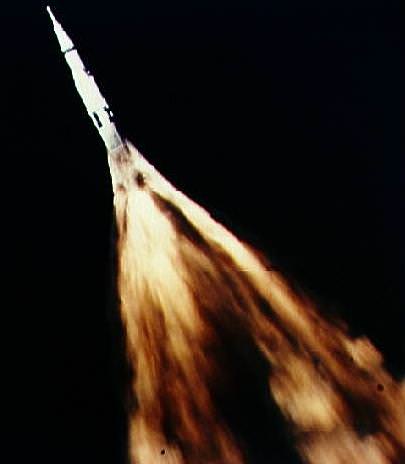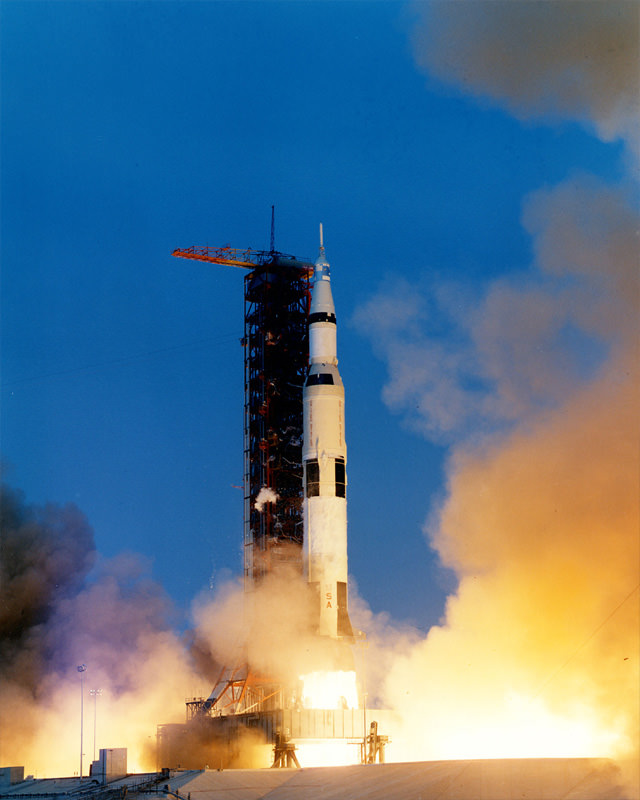Note: To celebrate the 40th anniversary of the Apollo 13 mission, for 13 days, Universe Today will feature “13 Things That Saved Apollo 13,” discussing different turning points of the mission with NASA engineer Jerry Woodfill.
While oxygen tank number two on the Apollo 13 spacecraft was an accident waiting to happen, another problem on the Saturn V rocket could have destroyed Apollo 13 before it reached Earth orbit. During the second-stage boost, the center – or inboard — engine shut down two minutes early. The shutdown wasn’t a problem, as the other four engines were able to compensate for the loss by operating for an extra four minutes. But why the engine shut down is a mystery that may have saved the mission.
“A catastrophic failure should have ensued,” said Apollo engineer Jerry Woodfill, “and would have, except for the unexplained behavior of the engine’s shutoff system. In fact, even the NASA Apollo 13 accident report fails to deal with the seriousness of the event.”
When the center engine shut down, it caused a few moments of uneasiness for Mission Control and the crew. Speaking after the flight, Commander Jim Lovell said that when NASA gave them the OK to carry on with the flight, “We all breathed a sigh of relief on the spacecraft. Hey, that was our crisis over with and we thought we’d have a smooth flight from then on.”
Woodfill said that the quick assessment in Mission Control was that a minor electrical signal failed to keep the engine operating so that it shut down prematurely. But that wasn’t the problem.
[/caption]
What happened was the Saturn V rocket experienced dangerous so-called “pogo” thrust oscillations, a problem NASA knew about. While a fix had been planned for Apollo 14, time did not permit its implementation on Apollo 13’s Saturn V.
“While a clerical error caused Apollo 13’s oxygen tank to explode,” said Woodfill, “because its heater design had not been updated for 65 volt operation, and the tank was a virtual bomb (see Part 1), similarly NASA’s failure to fix a known serious booster flaw should have destroyed Apollo 13.”
The Saturn V rocket had five J-2 engines, each producing 200,000 pounds of thrust, together creating the 1 million pounds of thrust needed for a mission to the Moon.
On previous Saturn flights, these pogo oscillations had occurred during launch. The phenomenon occurred as the fuel lines and structure of the rocket resonated at a common frequency. The resonance tended to amplify in force and potential destruction with each bounce of the “pogo” mechanism. So damaging was the phenomena on the unmanned Apollo 6 mission that an entire outer panel of the Saturn 5 ejected into space.

“The oscillations are like a jack hammer and it was so dreadful on Apollo 6 that it tore off a panel on the booster, and threatened the mission,” said Woodfill. “Apollo 6’s orbit was supposed to be circular, but because of the pogo effect and failure of second stage engines, the orbit became an elongated orbit of about 60 by 180 miles.”
Woodfill said if Apollo 13 had ended up in that type of orbit, it would have been bad but not fatal. However, Apollo 13 was a much different situation than Apollo 6.
The Apollo 6 mission carried a mock lunar lander of more modest mass than the “full-up” lander which Apollo 13 carried to orbit. With the added mass for Apollo 13, the pogo forces were suddenly a magnitude greater in intensity. A mission report said that the engine experienced 68g vibrations at 16 hertz, flexing the thrust frame by 3 inches (76 mm).
Woodfill said that if the center engine had continued running a few more seconds, the oscillations may have destroyed the vehicle. “That engine was pounding horizontally up and down, a quarter foot, at the rate of 16 times a second,” he said. “The engine had become a two ton sledge hammer, a deadly pogo stick of destruction, putting enormous forces on the supporting structures.”
What shut the engine down?

“It is, to this day, not fully understood, but it had something to do with fooling the engine’s thrust chamber pressure sensor that pressure was too low,” said Woodfill. He has studied the mission report, but says the complete analysis of why the engine shut down isn’t included.
“Though the shutdown command came from a low thrust chamber pressure sensor assessment, actually, the engine was operating correctly,” he said. ” The sensor had nothing to do with the pogo phenomenon. For some inexplicable reason, it was like something sucked the pressure out of the chamber and a sensor turned the engine off. But no one knows exactly why.”
Woodfill said those who later examined the situation said it was altogether lucky that the sensor shut down the engine. “Something intervened, stopping the engine from pounding its way from the mount into the fragile fuel tanks. This would have destroyed the Apollo 13 launch vehicle.”
As it was, the engine shutdown likely saved the Apollo 13 mission.
Tomorrow, Part 6: Navigation
Other articles from the “13 Things That Saved Apollo 13” series:
Part 2: The Hatch That Wouldn’t Close
Part 3: Charlie Duke’s Measles
Part 4: Using the LM for Propulsion
Part 5: Unexplained Shutdown of the Saturn V Center Engine
Part 6: Navigating by Earth’s Terminator
Part 8: The Command Module Wasn’t Severed
Part 12: Lunar Orbit Rendezvous
Part 13: The Mission Operations Team
Also:
Your Questions about Apollo 13 Answered by Jerry Woodfill (Part 1)
More Reader Questions about Apollo 13 Answered by Jerry Woodfill (part 2)
Final Round of Apollo 13 Questions Answered by Jerry Woodfill (part 3)
Never Before Published Images of Apollo 13’s Recovery
Listen to an interview of Jerry Woodfill on the 365 Days of Astronomy podcast.


I think the correct assessment for this mission would have to be, more than ever: Lucky Bastards.
“While a fix had been planned for Apollo 14, time did not permit its implementation on Apollo 13’s Saturn V.”
But did it really need to be the hindsight of the Apollo 13 launch to know that this was a dangerous thing to do? Was delaying the apollo 13 launch not an option?
Could be yet another case of politics taking precedence over safety, thankfully no longer a factor. At least until the Chinese start their advanced missions.
BTW. The ‘pogo’ effect is a phenomenon, not phenomena, which is plural 🙂
Ensure your grammar is correct if you feel you must correct the grammar of others.
For instance: Don’t use commas incorrectly when a semi-colon is correct for separating two independent phrases. Also, don’t use a sentence fragment when it doesn’t add to style or impact! 🙂
This is a BLOG… it isn’t meant to be formal. Keep the grammar police badges in your pockets.
Agree with Aodhhan. We might be a bunch of hopeless “space geeks”, but let’s get a life!
Beyond luck? Wow~
Another excellent article Nancy.